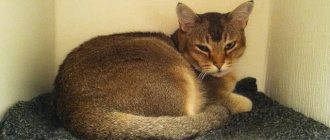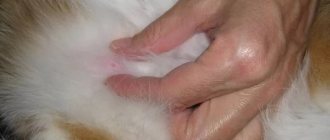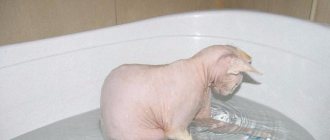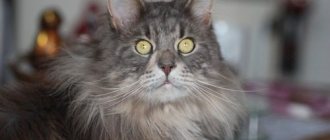22396Administration
1
The period of active growth and weight gain plays a special role in the development of a kitten. Determining the weight of a kitten at each stage of its development is necessary in order to notice deviations in the direction of underweight or overweight in time and take action. In order to control the kitten's weight by month, you can use a special table.
It is based on the average increase for each month in the period from 1 to 12. However, when using the table data, it should be taken into account that the weight of different breeds at the same age may differ slightly. For example, Maine Coon cubs weigh significantly more at birth than British breed cubs. Several other factors also influence the weight and size of a kitten:
- Floor. At birth, boys and girls usually do not differ much in weight, but after a few months this difference becomes noticeable;
- Number of individuals in the litter. It is known that the more individuals born in one litter, the greater their deviation towards underweight from the average statistical norm;
- Proper nutrition for cats during pregnancy and feeding. If during pregnancy and feeding the cat received all the substances necessary for her body, then the likelihood of harmoniously developing offspring becomes higher;
- A balanced diet for the baby after weaning him from the cat is one of the factors that is significant in terms of influence on the kitten’s normal weight;
- The health status of the animal. Violation of general health can negatively affect the development of an individual and normal weight gain.
© shutterstock
Kitten weight by month: table
Weight depends on many factors, which include breed, gender, size of parents, individual characteristics, etc. At birth, a kitten can weigh from 80 to 150 g. For example, Maine Coons, on average, give birth to 130-gram kittens, while British cats – 100 grams, and outbred cats weigh about 90 g at birth.
The table below shows averages of how much animals weigh depending on age and breed:
| Age | Maine Coon | British cat | Sphinx | Outbred |
| 1 Week | 180-250 g | 110-230 g | 100-220 g | 100-250 g |
| 2 week | 280-350 g | 150-300 g | 130-300 g | 150-300 g |
| 3 week | 420-570 g | 210-500 g | 200-430 g | 200-500 g |
| 1 month | 560-730 g | 250-650 g | 230-590 g | 250-650 g |
| 2 months | 1.1-1.5 kg | 450-900g | 420-800 g | 400-1kg |
| 3 months | 1.7-2.2 kg | 1-2.5 kg | 900-2 kg | 1-2 kg |
| 4 months | 2.7-3.7 kg | 1.7-3.5 kg | 1.3-2.7 kg | 1.5-2.5 kg |
| 5 months | 2.9-5.3 kg | 2.2-4 kg | 2.1-3.9 kg | 2-3 kg |
| 6 months | 3.2-6 kg | 2.3-4.5 kg | 2.2-4.3 kg | 2.5-4 kg |
| 7 months | 3.5-6.5 kg | 2.4-5 kg | 2.3-4.6 kg | 2.5-4.5 kg |
| 8 months | 3.8-6.7 kg | 2.5-5.5 kg | 2.4-4.9 kg | 2.5-5 kg |
| 9 months | 4.1-7 kg | 2.5-5.9 kg | 2.5-5.3 kg | 2.5-5.5 kg |
| 10 months | 4.3-7.7 kg | 2.6-6.4 kg | 2.6-5.8 kg | 2.6-6 kg |
| 11 months | 4.4 -8 kg | 2.7-6.8 kg | 2.7-6.4 kg | 2.8-6.5 kg |
| 1 year | 4.6-9 kg | 3-7 kg | 3-7 kg | 3-7 kg |
How do Bengals develop?
| Days, months | Events, activities |
| 5-8 days | The ear canal opens |
| 7-12 days | Eyes open |
| 12-21 days | The first teeth appear |
| 13-16 days | Ability to navigate by sound |
| from 14 days | Vision becomes clearer |
| from 18 days | First claw trimming Ability to stand on paws |
| 21-30 days | Learn to walk; Fang trimming and deworming if necessary |
| from 30 days | Start of complementary feeding, toilet training |
| 5-10 weeks | Routine prevention of helminths Immunity borrowed from the mother weakens |
| 6-16 week | Vaccination |
| 8-12 week | Revaccination |
| 3 months | Moving to a new home |
| 12-14 week | Permanent teeth appear, immunity decreases |
| 3.5-7 months. | Routine vaccination |
| 6 months | Puberty |
| 4-20 months | Sterilization, castration |
“Gaining excess weight is not common in Bengal kittens, but if it happens, you should contact your veterinarian.”
Weight gain in the first month
The first four weeks of life are characterized by the most intensive growth. The weight of a kitten in the 1st month can increase up to 15 g every day. At the end of this period, it can be two or even three times greater than at birth. Such intensive growth is noticeable to the naked eye. If at this age there is a slight gain in body weight, then you need to seek help from a veterinarian to diagnose and correct the situation.
In the first month, the kitten needs intensive care and good nutrition. The optimal diet is provided by mother's breast milk. However, a cat cannot always feed its offspring for various reasons. In this case, the role of “mother” falls on the pet owner. The best substitute for mother's milk are special industrial mixtures, the composition of which duplicates the natural components as much as possible. The dosage and frequency of feeding depend on the age and size of the animal. So, in the first week he should be fed about 4 ml every 2-4 hours, and in the second week - every 4-6 hours, 5 ml. With proper nutrition, by the end of the fourth week he will weigh 300-400 g, his first teeth will grow and he can already be given additional food.
In addition to rapid growth, signs of your pet’s health in the first four weeks of life will include:
- ability to stand on one’s paws (way and not confidently);
- active behavior;
- healthy sleep;
- regular bowel movements.
First week
Many consider this short period in a child’s life to be the most touching. The kitten is born completely helpless: it is blind, does not hear anything and navigates the new world only by smells. By the way, studies have shown that, among thousands of other aromas, a small cat can smell the scent of its mother, who at that moment in a kitten’s life is not only the closest creature, but also a source of nutrition and care. The kitten does not yet know how to feed itself, so usually the animal, together with its brothers and sisters, is breastfed by its mother.
The babies also don’t go to the toilet yet - the cat licks them. The kitten's fur is thin, so it often gets cold and needs to be warmed near its mother. The bones are also not yet strong, so it is not recommended to pick up, hug, or actively play with very small pets. A newborn cat baby weighs only about 100 grams and reaches a length of up to 10 centimeters. Like human babies, the heirs of the feline family mainly eat and sleep in early childhood, during which time their body, including the nervous system, actively develops.
At the age of three days, the kitten loses its umbilical cord, and at five days the baby can already hear the world around him. Very small pets do not yet stand on their legs, but can already crawl around the room for short distances.
At the age of two weeks, the kitten already weighs up to two hundred grams, it develops good hearing, but the source of the sound is still difficult for the animal to determine. During the same period, the baby’s eyes open, but he still sees vaguely and cannot navigate in space based on the information received by vision. The kitten's fur becomes thicker and thermoregulation improves. The little pet is not yet able to walk, but he spends much more time in a state of wakefulness.
Kitten weight at 2-3 months
During this period, intensive weight gain continues, although not as active as before. For every 30 days, the kitten almost doubles in size, and by the end of the 3rd month it will weigh approximately 1.5-2 kg. He can already eat soft food, so you should diversify his diet and don’t forget about water. Stores sell special food for kittens, which may come in the form of a pate or soft pieces in a sauce. Since the small pet is already actively exploring the territory, it is necessary to limit its access to adult food, which will be too tough for it.
Getting used to a new place and training to a tray
At first, the kitten will miss its previous home, meows at night, pick it up and stroke it, talk to it. Caring for British kittens at 2 months is exactly like this. At night, you can put him on a warm heating pad, wrapping it in a towel (this will remind him of his mother or the presence of other kittens nearby). Take your time, let the Brit get comfortable.
shutterstock
If the animal was purchased from a nursery, they are often already litter box trained. If not, then it won't be difficult. After feeding, take your Brit to the toilet. It is better to fill the tray with wood filler. He will like it there and will quickly remember where to go. The tray should always be clean, this is the key to avoiding embarrassment. If there is an embarrassment, then it is worth punishing the kitten.
You shouldn't hit the kitten; a loud sound or clap is enough to make it scared; you can spray it with water.
This will develop a conditioned reflex and after the third time the kitten will understand that this is not worth doing. Never allow a cat's unacceptable behavior to go unpunished.
The norm is 4-5 months
At this age, the average weight of a kitten is 1.5-3 kg. The period of intensive growth has ended, but the pet still continues to gain weight. At the end of the 5th month, males can reach 4 kg.
Your pet still needs to eat baby food frequently. The number of feedings is up to 5 times. Diets should be chosen with the maximum protein content, which is necessary for the normal development of the growing predator’s body. Industrially produced food is marked with the appropriate inscription “For kittens”. However, it is necessary to carefully study the composition in order to choose a quality nutrition.
Cat weight at 8-12 months
By the time a cat is one year old, it is considered an adult. Its dimensions practically do not change, and on average reach 4-6 kg depending on the breed and gender. By the age of one year, it is necessary to reduce meals to two times a day and monitor its balance. It is important to feed animals with good food, in which the protein level is more than 30% (if we talk about industrially produced feed). High-quality balanced nutrition will be the key to the normal functioning of the cat’s body and is the prevention of obesity.
Common Digestive Problems
Feeding at 4 months is a challenging task for kitten breeders. If food is not given in porridge form, the animal may become constipated. And when prohibited foods are included in the diet, diarrhea occurs. In such a situation, the question arises: what is the treatment for diarrhea in a 4-month-old kitten? In what cases can you cope on your own, and when is it better to go to a veterinary clinic?
You should contact your veterinarian immediately if:
- Vomiting and diarrhea are present at the same time;
- There is diarrhea with blood;
- The disorder recurs more than 4 times a day.
Self-treatment involves a daily starvation diet. You can give the kitten a rehydron solution or salted water. A decoction of rice or a mixture of oak bark helps stop diarrhea when it is caused by poor diet. A decoction of flax seeds or oatmeal also perfectly helps eliminate the symptoms of the disease.
Children's smecta and activated charcoal should be given in case of illness. Bifidobacteria or lactobacilli can be given with a small amount of food on the second day of treatment.
When treating at home, you do not need to prescribe antibiotics to your cat yourself. At 4 months they will destroy all the microflora of his intestines. When diarrhea is severe, it is worth finding out the cause of the disease and eliminating it.
Weighing procedure
To find out how much a kitten weighs, you can use a kitchen scale in the first months. A small pet will fit well in a bowl or bowl. In the future, you can use a canter scale by placing the animal in a bag with two handles or a basket. It is necessary to subtract the weight of the bag itself from the result obtained in order to obtain reliable data. Using the subtraction method, you can also weigh your pet using floor scales, which the owner first stands on himself, and then with the pet.
Weighing an animal may be required in the following cases:
- artificial feeding;
- pathologies at birth;
- suspicion of developing the disease;
- development control.
Dangerous symptoms
Poor nutrition, lack of activity and weight control lead to overeating or undereating in cats. An outbred individual is able to independently control the amount of food eaten. Pedigree cats and animals in adulthood are characterized by a weak instinct towards food. Excessive eating leads to obesity.
The following symptoms help to recognize the disease: fat deposits, fatigue, apathy, lack of interest in games and shortness of breath. A malnourished cat is characterized by poor weight gain, bone visualization, and frequent illness. The presence of one or more symptoms requires immediate consultation with a veterinarian.











